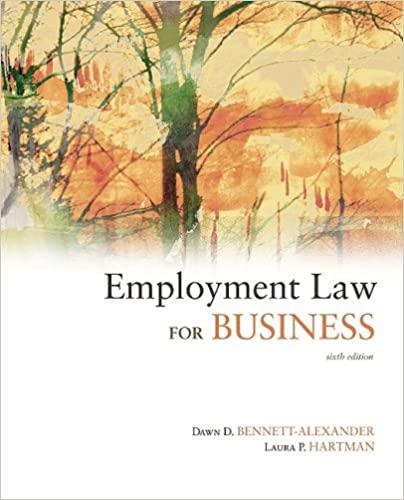Question
Please respond to this discussion post below thoroughly and detailed. Terry v. the Supreme Court set down a legal benchmark in 1968 for the stop
Please respond to this discussion post below thoroughly and detailed.
Terry v. the Supreme Court set down a legal benchmark in 1968 for the stop and frisk-also called a Terry stop-of a person in Ohio. A valid Terry stop can occur when law enforcement officers have reasonable suspicion that an individual is, was, or is about to be involved in some sort of criminal activity. In place of being based on a mere hazy suspicion or an unspecific hunch, this reasonable suspicion is supposed to be based upon specific and articulable facts. The officer may also conduct a limited pat-down search of the suspect for weapons if the officer believes the suspect might be armed and dangerous. Another requirement that has been attached to this is that the stop should not last any longer than necessary. The important facts of this scenario were that; A. whether police had reasonable suspicion to stop Zackary. b. Whether the First, Fourth, Fifth and Fourteenth Amendments apply to the Texas statute requiring an individual to identify himself during a Terry stop. The Texas statute requiring a person to provide identification in the course of a Terry stop implicates longstanding First, Fourth, Fifth, and Fourteenth Amendment issues. To the extent this statute requires identification without requiring officers to have reasonable suspicion, it violates a person's Fourth Amendment right against unreasonable searches and seizures. This is also violative of the right against self-incrimination under the Fifth Amendment because people may incriminate themselves with their identification. It could also violate the Equal Protection Clause of the Fourteenth Amendment if the statute were to be applied in a partial or discriminatory way. Thus, the constitutional issue here is whether the Texas statute passed muster when taken in perspective against Terry stops and individual rights under different amendments to the Constitution. In this case of Zackary and the arrest, the officer had no probable cause to stop him. The legality of the initial stop becomes the threshold that measures the validity of the arrest, therefore the stop was illegal. The evidence and actions that resulted from the illegal stop, therefore, including the arrest for failure to identify himself, would be considered "fruit of the poisonous tree" and thus inadmissible. The seizure was not valid in light of the fact that it was a direct result of the illegal Terry stop. Finally, the police, under this case, did not have probable cause to stop Zackary using a Terry stop. Consequently, the unconstitutional stop that resulted in Zackary's arrest was invalid, and the charges against him should have been dismissed. Given there was no reasonable suspicion in this case, the Texas statute identification requirement can be constitutionally attacked as for a Terry stop.
Step by Step Solution
There are 3 Steps involved in it
Step: 1

Get Instant Access to Expert-Tailored Solutions
See step-by-step solutions with expert insights and AI powered tools for academic success
Step: 2

Step: 3

Ace Your Homework with AI
Get the answers you need in no time with our AI-driven, step-by-step assistance
Get Started


